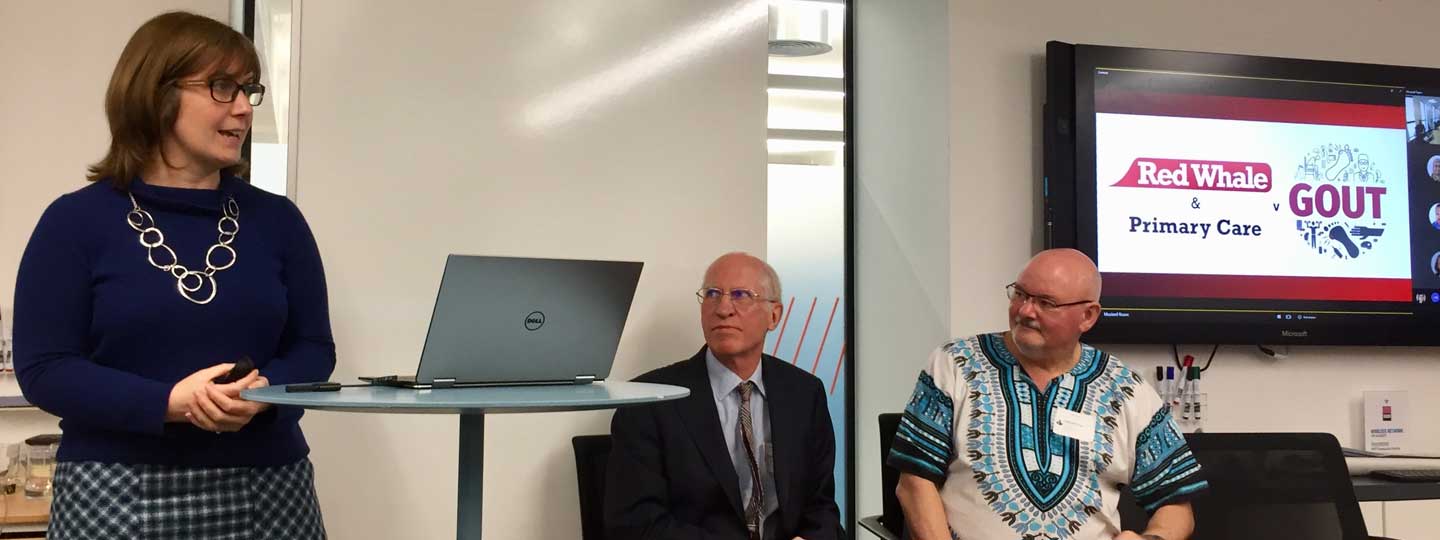Nurse-led care and patient inclusion improves gout treatment
20 February 2020
Gout is a very painful form of arthritis caused by crystals that form in and around the joints. An attack of gout can be excruciating, and continuing crystal formation can cause long-term joint damage.
Gout is the most common type of inflammatory arthritis and you can easily test and diagnose it by checking uric acid levels in the blood.
There are effective drugs which can help to lower urate levels and are currently being developed to provide clearer information on this.
Testing the effectiveness of nurse-led care
We funded trials to look at the effectiveness of nurse delivered care for gout patients, which included individualised information and patient involvement.
The research was led by Professor Michael Doherty at the University of Nottingham. Here, he shares more about why these studies are vital to develop better treatments.
“Gout is not taken as seriously as other conditions. There’s lots of misconceptions and people think it might not be that bad. Our challenge is to raise awareness about gout, share the latest research and improve treatment options.
Urate lowering therapy will help treat severe gout, although it may take a few years to get rid of the urate crystals. Also, the treatment will need to be taken for life to keep the condition under control.”
“It’s been well-studied that nurses can do very well managing certain chronic conditions following diagnosis."
"We wanted to test this out with gout treatments and got funding from Versus Arthritis to do a 1-year trial. By the end, everyone wanted urate lowering therapy. And 9 out of 10 people on the therapy were successfully treated.”
“We ran a follow up trial with 570 participants in the Nottinghamshire/East Midlands area over a 2-year period. Patients either received nurse led care or they continued with care under their GP.
After 2 years, there were far fewer gout attacks in the nurse led group and quality of life was better.” Read more about the research.
How will this research benefit people with gout?
Malcolm Coy shares his story of living with gout and how taking part in this research has been life-changing for him.
“When the GP told me I had gout, I was gob smacked. I had gout attacks and was put on allopurinol at 100mg. But over 5 years I got worse and the pain got worse. I was in the Marines and I’ve been shot, stabbed and blown up and the pain of that was nothing compared to gout.”
“Gout was taking over my life. I was in a dark place and thought about taking my life, I was at ground zero."
"I did some research and found out about Professor Doherty and his trial at my local hospital. I shared my desperation and got invited to be part of the study.
It was a shock to find out my level of uric acid. Before I had this knowledge, I thought I was doing something wrong. I didn’t realise that different people require different dosages of the urate lowering medication.”
“Thanks to the trial my dosage of allopurinol was increased to 500mg and I got my life back within a year.
I’m gout free now and I’m passionate about getting the message out there that gout is easily treatable. People don’t need to suffer that level of pain.”
What does this research mean for the future?
The research findings from the trials demonstrate that full patient involvement and education can lead to really good results.
Professor Michael Doherty said:
“We’re now looking to use our best practice model in GP practices to show that it is feasible and cost effective. We want to train practice nurses and even look at linking gout checks with yearly cardiovascular assessments. This approach would help us to check urate levels regularly and treat the condition as soon as signs of gout start to appear, which would help lots of people.”
How will this best practice help GPs work together with patients to treat gout?
We’re committed to working with healthcare professionals by sharing knowledge and the latest research to do more for people living with gout.
Dr Caroline Green, a GP and clinical lead on our Versus Arthritis and Red Whale webinars for healthcare professionals said:
“It’s my job as a GP to give a good explanation of gout at the beginning to help the patient understand what to expect. Communication is key as things might get worse before they get better."
"Between attacks, gout patients can have no symptoms, and so it’s easy to stop a drug if you’re not constantly seeing the benefits.
Also, we want to be looking at health holistically and not just joint health. For example, whenever we see gout diagnosed, we should look at heart assessments and the risk of diabetes at the same time. “
“This ties into Michael’s research, as the management of long-term conditions under nurse led or clinical pharmacist care makes sense and could work really well. We hope to see improvements for more gout patients as time goes on.”
Read more about our research achievements.
We’re here whenever you need us.
- If you would like to talk to someone, you can call our free helpline on 0800 5200 520
- Chat to our Arthritis Virtual Assistant
- Join our online community
- Stay in touch and follow us on Twitter, Facebook and Instagram.